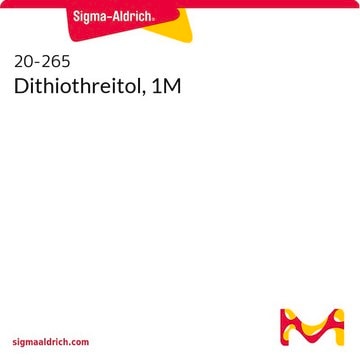If this product has an expiration or retest date, it will be shown on the Certificate of Analysis (COA, CofA). If there is no retest or expiration date listed on the product's COA, we do not have suitable stability data to determine a shelf life. For these products, the only date on the COA will be the release date; a retest, expiration, or use-by-date will not be displayed.
For all products, we recommend handling per defined conditions as printed in our product literature and website product descriptions. We recommend that products should be routinely inspected by customers to ensure they perform as expected.
For products without retest or expiration dates, our standard warranty of 1 year from the date of shipment is applicable.
For more information, please refer to the Product Dating Information document: https://www.sigmaaldrich.com/deepweb/assets/sigmaaldrich/marketing/global/documents/449/386/product-dating-information-mk.pdf
Kluczowe dokumenty
D0632
DL-Dithiothreitol
≥98% (HPLC), ≥99.0% (titration)
Synonim(y):
(±)-Dithiothreitol, rac-Dithiothreitol, Dithiothreitol, threo-1,4-Dimercapto-2,3-butanediol, Cleland’s reagent, DTT
Wybierz wielkość
272,00 zł
Wybierz wielkość
About This Item
272,00 zł
Polecane produkty
Poziom jakości
Próba
≥98% (HPLC)
≥99.0% (titration)
Formularz
powder
przydatność reakcji
reagent type: reductant
kolor
white
mp
41-44 °C (lit.)
rozpuszczalność
H2O: soluble 50 mg/mL, clear, colorless to very faintly yellow
Zastosowanie
general analytical
temp. przechowywania
2-8°C
ciąg SMILES
O[C@H](CS)[C@H](O)CS
InChI
1S/C4H10O2S2/c5-3(1-7)4(6)2-8/h3-8H,1-2H2/t3-,4-/m1/s1
Klucz InChI
VHJLVAABSRFDPM-QWWZWVQMSA-N
Szukasz podobnych produktów? Odwiedź Przewodnik dotyczący porównywania produktów
Opis ogólny
Zastosowanie
- as one of the reactants in the reduction and alkylation of αs1-Casein, the major allergen of cow′s milk.[1]
- as a component of medium for the demembranation and reactivation of spermatozoa.[2]
- to maintain stability of the enzyme as thiol effectively protects the active sites of the biocatalyst.[3]
- as a reducing agent to test the specificity of the reaction of N-Ethylmaleimide with sulfhydryl groups.[4]
- in proteomics analysis as in-solution protein digestion for mass spectrometry[5]
- as a buffer component for protein quantification, to prepare wash buffer, lysis buffer, sample buffer, and protein elution buffer[6][4]
Działania biochem./fizjol.
Cechy i korzyści
- High-quality DTT (HPLC≥98%), (titration≥99.0%)
- Suitable for electrophoresis, proteomics analysis
Inne uwagi
najczęściej kupowane z tym produktem
produkt podobny
zalecane rękawice chroniące przed rozpryskami
Hasło ostrzegawcze
Danger
Zwroty wskazujące rodzaj zagrożenia
Zwroty wskazujące środki ostrożności
Klasyfikacja zagrożeń
Acute Tox. 4 Oral - Eye Dam. 1 - Skin Irrit. 2
Kod klasy składowania
11 - Combustible Solids
Klasa zagrożenia wodnego (WGK)
WGK 3
Temperatura zapłonu (°F)
Not applicable
Temperatura zapłonu (°C)
Not applicable
Środki ochrony indywidualnej
dust mask type N95 (US), Eyeshields, Faceshields, Gloves
Wybierz jedną z najnowszych wersji:
Certyfikaty analizy (CoA)
Nie widzisz odpowiedniej wersji?
Jeśli potrzebujesz konkretnej wersji, możesz wyszukać konkretny certyfikat według numeru partii lub serii.
Masz już ten produkt?
Dokumenty związane z niedawno zakupionymi produktami zostały zamieszczone w Bibliotece dokumentów.
Klienci oglądali również te produkty
Produkty
Compare columns in resolving medium-sized antibody fragments after digestion with DTT or IdeS using Reversed-Phase Chromatography for analysis.
-
How can I determine the shelf life / expiration / retest date of this product?
1 answer-
Helpful?
-
-
How is shipping temperature determined? And how is it related to the product storage temperature?
1 answer-
Products may be shipped at a different temperature than the recommended long-term storage temperature. If the product quality is sensitive to short-term exposure to conditions other than the recommended long-term storage, it will be shipped on wet or dry-ice. If the product quality is NOT affected by short-term exposure to conditions other than the recommended long-term storage, it will be shipped at ambient temperature. As shipping routes are configured for minimum transit times, shipping at ambient temperature helps control shipping costs for our customers. For more information, please refer to the Storage and Transport Conditions document: https://www.sigmaaldrich.com/deepweb/assets/sigmaaldrich/marketing/global/documents/316/622/storage-transport-conditions-mk.pdf
Helpful?
-
-
How long can the powder be left out a room temperature?
1 answer-
The long term storage recommendation for this product is refrigerated at 2-8°C, but is shipped at ambient temperature. Refrigerated products that ship at ambient temperature are stable for up to 2 weeks to allow for transit time. Items left at room temperature for short periods will not be adversely effected.
Helpful?
-
-
What is the shelf life of this product once the stock solution is made up please?
1 answer-
A solution of DTT in Hepes buffer, pH 7.75 is stable for one week at 2 to 8 °C if the container is tightly sealed and the solution is protected from atmospheric oxygen by argon or nitrogen.
Helpful?
-
Active Filters
Nasz zespół naukowców ma doświadczenie we wszystkich obszarach badań, w tym w naukach przyrodniczych, materiałoznawstwie, syntezie chemicznej, chromatografii, analityce i wielu innych dziedzinach.
Skontaktuj się z zespołem ds. pomocy technicznej




